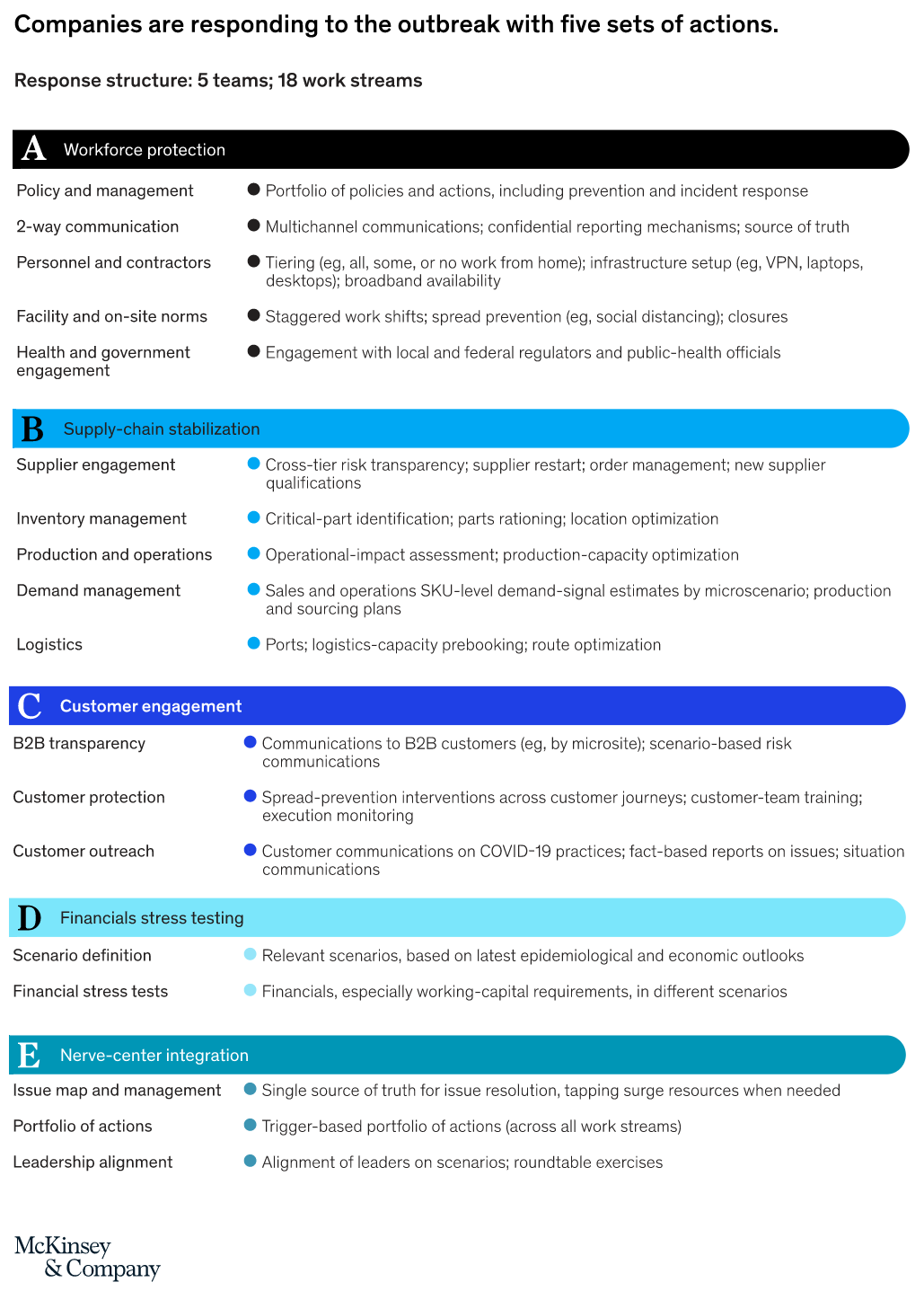[dropcap]T[/dropcap]he coronavirus crisis is a story with an unclear ending. What is clear is that the human impact is already tragic, and that companies have an imperative to act immediately to protect their employees, address business challenges and risks, and help to mitigate the outbreak in whatever ways they can.
McKinsey & Company outlined for their client, and make it available for a wider audience, an interesting report entitled “Coronavirus’s business impact”, as an aid to leaders in their crisis management. In this report McKinsey outlined the three possibile scenarios every company should be ready to face, explored the 5 actions companies are putting into pratice and suggested the seven actions that could help businesses of all kinds. COVID-19 is also serving as an accelerant for companies to make strategic, longer-term changes to supply chains—changes that had often already been under consideration.
We offer here below an abstract. At this link you can find the full report.
[divider style=”solid” top=”20″ bottom=”20″]
While every country’s response is unique, there are three archetypes emerging—two successful and one not—that offer valuable lessons.
- Extraordinary measures to limit spread
- Gradual control through effective use of public-health best practices
- Unsuccessful initial control, leading to overwhelmed health systems
The scenarios below outline two ways that the interplay between the virus and society’s response might unfold and the implications on the economy in each case.
1/ Delayed recovery
Epidemiology. In this scenario, new case counts in the Americas and Europe rise until mid-April. Asian countries peak earlier; epidemics in Africa and Oceania are limited. Growth in case counts is slowed by effective social distancing through a combination of national and local quarantines, employers choosing to restrict travel and implement work-from-home policies, and individual choices. Testing capacity catches up to need, allowing an accurate picture of the epidemic. The virus proves to be seasonal, further limiting its spread. By mid-May, public sentiment is significantly more optimistic about the epidemic. The Southern Hemisphere winter sees an uptick in cases, but by that point, countries have a better-developed playbook for response. While the autumn of 2020 sees a resurgence of infections, better preparedness enables continued economic activity.
Economic impact. Large-scale quarantines, travel restrictions, and social-distancing measures drive a sharp fall in consumer and business spending until the end of Q2, producing a recession. Although the outbreak comes under control in most parts of the world by late in Q2, the self-reinforcing dynamics of a recession kick in and prolong the slump until the end of Q3. Consumers stay home, businesses lose revenue and lay off workers, and unemployment levels rise sharply. Business investment contracts, and corporate bankruptcies soar, putting significant pressure on the banking and financial system.
Monetary policy is further eased in Q1 but has limited impact, given the prevailing low interest rates. Modest fiscal responses prove insufficient to overcome economic damage in Q2 and Q3. It takes until Q4 for European and US economies to see a genuine recovery. Global GDP in 2020 falls slightly.
2/ Prolonged contraction
Epidemiology. In this scenario, the epidemic does not peak in the Americas and Europe until May, as delayed testing and weak adoption of social distancing stymie the public-health response. The virus does not prove to be seasonal, leading to a long tail of cases through the rest of the year. Africa, Oceania, and some Asian countries also experience widespread epidemics, though countries with younger populations experience fewer deaths in percentage terms. Even countries that have been successful in controlling the epidemic (such as China) are forced to keep some public-health measures in place to prevent resurgence.
Economic impact. Demand suffers as consumers cut spending throughout the year. In the most affected sectors, the number of corporate layoffs and bankruptcies rises throughout 2020, feeding a self-reinforcing downward spiral.
The financial system suffers significant distress, but a full-scale banking crisis is averted because of banks’ strong capitalization and the macroprudential supervision now in place. Fiscal and monetary-policy responses prove insufficient to break the downward spiral.
The global economic impact is severe, approaching the global financial crisis of 2008–09. GDP contracts significantly in most major economies in 2020, and recovery begins only in Q2 2021.
[divider style=”solid” top=”20″ bottom=”20″]
Conversations with hundreds of companies around the world on COVID-19 challenges have allowed McKinsey & Company to compile a view of the major work streams that companies are pursuing:
In our analysis, three broad economic scenarios might unfold: a quick recovery, a global slowdown, and a pandemic-driven recession. Here, we outline all three. We believe that the prevalent pessimistic narrative (which both markets and policy makers seem to favor as they respond to the virus) underweights the possibility of a more optimistic outcome to COVID-19 evolution.
1/ Quick recovery
In this scenario, case count continues to grow, given the virus’s high transmissibility. While this inevitably causes a strong public reaction and drop in demand, other countries are able to achieve the same rapid control seen in China, so that the peak in public concern comes relatively soon (within one to two weeks). Given the low fatality rates in children and working-age adults, we might also see levels of concern start to ebb even as the disease continues to spread. Working-age adults remain concerned about their parents and older friends, neighbors, and colleagues, and take steps to ensure their safety. Older people, especially those with underlying conditions, pull back from many activities. Most people outside the transmission complexes continue their normal daily lives.
The scenario assumes that younger people are affected enough to change some daily habits (for example, they wash hands more frequently) but not so much that they shift to survival mode and take steps that come at a higher cost, such as staying home from work and keeping children home from school. A complicating factor, not yet analyzed, is that workers in the gig economy, such as rideshare drivers, may continue to report to work despite requests to stay home, lest they lose income. This scenario also presumes that the virus is seasonal.
In this scenario, our model developed in partnership with Oxford Economics suggests that global GDP growth for 2020 falls from previous consensus estimates of about 2.5 percent to about 2.0 percent. The biggest factors are a fall in China’s GDP from nearly 6 percent growth to about 4.7 percent; a one-percentage-point drop in GDP growth for East Asia; and drops of up to 0.5 percentage points for other large economies around the world. The US economy recovers by the end of Q1. By that point, China resumes most of its factory output; but consumer confidence there does not fully recover until end Q2. These are estimates, based on a particular scenario. They should not be considered predictions.
2/ Global slowdown
This scenario assumes that most countries are not able to achieve the same rapid control that China managed. In Europe and the United States, transmission is high but remains localized, partly because individuals, firms, and governments take strong countermeasures (including school closings and cancellation of public events). For the United States, the scenario assumes between 10,000 and 500,000 total cases. It assumes one major epicenter with 40 to 50 percent of all cases, two or three smaller centers with 10 to 15 percent of all cases, and a “long tail” of towns with a handful or a few dozen cases. This scenario sees some spread in Africa, India, and other densely populated areas, but the transmissibility of the virus declines naturally with the northern hemisphere spring.
This scenario sees much greater shifts in people’s daily behaviors. This reaction lasts for six to eight weeks in towns and cities with active transmission, and three to four weeks in neighboring towns. The resulting demand shock cuts global GDP growth for 2020 in half, to between 1 percent and 1.5 percent, and pulls the global economy into a slowdown, though not recession.
In this scenario, a global slowdown would affect small and mid-size companies more acutely. Less developed economies would suffer more than advanced economies. And not all sectors are equally affected in this scenario. Service sectors, including aviation, travel, and tourism, are likely to be hardest hit. Airlines have already experienced a steep fall in traffic on their highest-profit international routes (especially in Asia–Pacific). In this scenario, airlines miss out on the summer peak travel season, leading to bankruptcies (FlyBe, the UK regional carrier, is an early example) and consolidation across the sector. A wave of consolidation was already possible in some parts of the industry; COVID-19 would serve as an accelerant.
In consumer goods, the steep drop in consumer demand will likely mean delayed demand. This has implications for the many consumer companies (and their suppliers) that operate on thin working-capital margins. But demand returns in May–June as concern about the virus diminishes. For most other sectors, the impact is a function primarily of the drop in national and global GDP, rather than a direct impact of changed behaviors. Oil and gas, for instance, will be adversely affected as oil prices stay lower than expected until Q3.
3/ Pandemic and recession
This scenario is similar to the global slowdown, except it assumes that the virus is not seasonal (unaffected by spring in the northern hemisphere). Case growth continues throughout Q2 and Q3, potentially overwhelming healthcare systems around the world and pushing out a recovery in consumer confidence to Q3 or beyond. This scenario results in a recession, with global growth in 2020 falling to between –1.5 percent and 0.5 percent.
[divider style=”solid” top=”20″ bottom=”20″]
Seven actions can help businesses of all kinds. Mc Kinsey outlined them here as an aid to leaders as they think through crisis management for their companies. These are only guidelines; they are by no means exhaustive or detailed enough to substitute for a thorough analysis of a company’s particular situation.
Protect your employees. The COVID-19 crisis has been emotionally challenging for many people, changing day-to-day life in unprecedented ways. For companies, business as usual is not an option. They can start by drawing up and executing a plan to support employees that is consistent with the most conservative guidelines that might apply and has trigger points for policy changes. Some companies are actively benchmarking their efforts against others to determine the right policies and levels of support for their people. Some of the more interesting models we have seen involve providing clear, simple language to local managers on how to deal with COVID-19 (consistent with WHO, CDC, and other health-agency guidelines) while providing autonomy to them so they feel empowered to deal with any quickly evolving situation. This autonomy is combined with establishing two-way communications that provide a safe space for employees to express if they are feeling unsafe for any reason, as well as monitoring adherence to updated policies.
Set up a cross-functional COVID-19 response team. Companies should nominate a direct report of the CEO to lead the effort and should appoint members from every function and discipline to assist. Further, in most cases, team members will need to step out of their day-to-day roles and dedicate most of their time to virus response. A few workstreams will be common for most companies: a) employees’ health, welfare, and ability to perform their roles; b) financial stress-testing and development of a contingency plan; c) supply-chain monitoring, rapid response, and long-term resiliency (see below for more); d) marketing and sales responses to demand shocks; and e) coordination and communication with relevant constituencies. These subteams should define specific goals for the next 48 hours, adjusted continually, as well as weekly goals, all based on the company’s agreed-on planning scenario. The response team should install a simple operating cadence and discipline that focuses on output and decisions, and does not tolerate meetings that achieve neither.
Ensure that liquidity is sufficient to weather the storm. Businesses need to define scenarios tailored to the company’s context. For the critical variables that will affect revenue and cost, they can define input numbers through analytics and expert input. Companies should model their financials (cash flow, P&L, balance sheet) in each scenario and identify triggers that might significantly impair liquidity. For each such trigger, companies should define moves to stabilize the organization in each scenario (optimizing accounts payable and receivable; cost reduction; divestments and M&A).
Stabilize the supply chain. Companies need to define the extent and likely duration of their supply-chain exposure to areas that are experiencing community transmission, including tier-1, -2, and -3 suppliers, and inventory levels. Most companies are primarily focused on immediate stabilization, given that most Chinese plants are currently in restart mode. They also need to consider rationing critical parts, prebooking rail/air-freight capacity, using after-sales stock as a bridge until production restarts, gaining higher priority from their suppliers, and, of course, supporting supplier restarts. Companies should start planning how to manage supply for products that may, as supply comes back on line, see unusual spikes in demand due to hoarding. In some cases, medium or longer-term stabilization may be warranted, which calls for updates to demand planning, further network optimization, and searching for and accelerating qualification of new suppliers. Some of this may be advisable anyway, absent the current crisis, to ensure resilience in their supply chain—an ongoing challenge that the COVID-19 situation has clearly highlighted.
Stay close to your customers. Companies that navigate disruptions better often succeed because they invest in their core customer segments and anticipate their behaviors. In China, for example, while consumer demand is down, it has not disappeared—people have dramatically shifted toward online shopping for all types of goods, including food and produce delivery. Companies should invest in online as part of their push for omnichannel distribution; this includes ensuring the quality of goods sold online. Customers’ changing preferences are not likely to go back to pre-outbreak norms.
Practice the plan. Many top teams do not invest time in understanding what it takes to plan for disruptions until they are in one. This is where roundtables or simulations are invaluable. Companies can use tabletop simulations to define and verify their activation protocols for different phases of response (contingency planning only, full-scale response, other). Simulations should clarify decision owners, ensure that roles for each top-team member are clear, call out the “elephants in the room” that may slow down the response, and ensure that, in the event, the actions needed to carry out the plan are fully understood and the required investment readily available.
Demonstrate purpose. Businesses are only as strong as the communities of which they are a part. Companies need to figure out how to support response efforts—such as by providing money, equipment, or expertise. For example, a few companies have shifted production to create medical masks and clothing.
Conclusion /Economic impact
In McKinsey base-case scenario, continued spread within established complexes, as well as community transmission in new complexes, drives a 0.3- to 0.7-percentage-point reduction in global GDP growth for 2020. China, meanwhile, continues on its path to recovery, achieving a near-complete economic restart by mid-Q2 (in spite of the current challenges of slow permissions and lack of migrant-worker capacity). As other geographies experience continued case growth, it is likely that movement restrictions will be imposed to attempt to stop or slow the progression of the disease. This will almost certainly drive a sharp reduction in demand, which in turn lowers economic growth through Q2 and early Q3. Demand recovery will depend on a slowing of case growth, the most likely cause of which would be “seasonality”—a reduction in transmissions similar to that seen with influenza in the northern hemisphere as the weather warms. Demand may also return if the disease’s fatality ratio proves to be much lower than we are currently seeing.
Regions that have not yet seen rapid case growth (such as the Americas) are increasingly likely to see more sustained community transmission (for example, expansion of the emergency clusters in the western United States). Greater awareness of COVID-19, plus additional time to prepare, may help these complexes manage case growth. However, complexes with less robust health systems could see more general transmission. Lower demand could slow growth of the global economy between 1.8 percent and 2.2 percent instead of the 2.5 percent envisioned at the start of the year.
Unsurprisingly, sectors will be affected to different degrees. Some sectors, like aviation, tourism, and hospitality, will see lost demand (once customers choose not to eat at a restaurant, those meals stay uneaten). This demand is largely irrecoverable. Other sectors will see delayed demand. In consumer goods, for example, customers may put off discretionary spending because of worry about the pandemic but will eventually purchase such items later, once the fear subsides and confidence returns. These demand shocks—extended for some time in regions that are unable to contain the virus—can mean significantly lower annual growth. Some sectors, such as aviation, will be more deeply affected.
In the pessimistic scenario, case numbers grow rapidly in current complexes and new centers of sustained community transmission erupt in North America, South America, and Africa. Our pessimistic scenario assumes that the virus is not highly seasonal, and that cases continue to grow throughout 2020. This scenario would see significant impact on economic growth throughout 2020, resulting in a global recession.
In both the base-case and pessimistic scenarios, in addition to facing consumer-demand headwinds, companies will need to navigate supply-chain challenges. Currently, we see that companies with strong, centralized procurement teams and good relationships with suppliers in China are feeling more confident about their understanding of the risks these suppliers face (including tier-2 and tier-3 suppliers). Others are still grappling with their exposure in China and other transmission complexes. Given the relatively quick economic restart in China, many companies are focused on temporary stabilization measures rather than moving supply chains out of China. COVID-19 is also serving as an accelerant for companies to make strategic, longer-term changes to supply chains—changes that had often already been under consideration.







